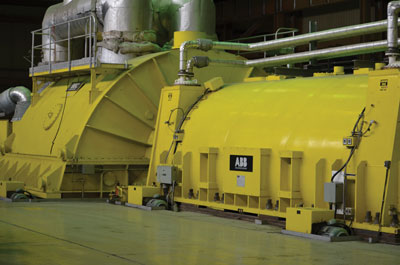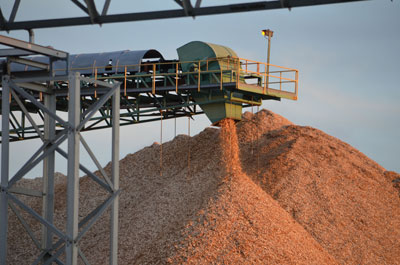
End of an Era
November 29, 2012
By
Andrew Macklin
When the Ontario government introduced the Green Energy Act in 2009, it sought to create a greener economy.
When the Ontario government introduced the Green Energy Act in 2009, it sought to create a greener economy. The elimination of coal-fired energy generation, targeted for the end of 2014, meant that there would be a need for an increased amount of renewable energy solutions for Ontario’s energy supply mix. But it also meant that it was up to Ontario Power Generation to find new solutions for generating electricity at several key power stations across the province.
 |
|
| Construction is underway on the west side of the OPG Atikokan site, which will house the wood pellet storage and handling facilities.
|
“OPG is committed to making sure that all coal-fired plants in Ontario are converted on schedule, by the end of 2014,” said Chris Fralick, plant manager, northwest thermal for OPG.
One of the four coal-fired generating stations affected by the Green Energy Act and operated by OPG, is located on the outskirts of Atikokan, Ont, a community of close to 3,000 located 200 kilometres west of Thunder Bay. The facility opened in 1985 using coal-fired power generation. At its peak, the generating unit can produce up to 211 megawatts of power. Annually, the plant produces as much as 1 billion kilowatt-hours of electricity, or enough to supply approximately 83,000 homes and businesses for one year. The power supply is primarily used to provide power during peak demand times, as well as to back up electricity generation. To generate that much power, the Atikokan facility burns 90,000 tonnes of coal annually.
The coal being used to power OPG’s Atikokan was low sulphur lignite coal, which was being transported by train from Western Canada. The coal was burned in a lignite-fired boiler, which uses recirculated flue gas from the top of the boiler to heat and remove moisture from the coal. Once the lignite is dried, it has the tendency to ignite spontaneously. However, the use of flue gas as the drying method does help to prevent that. Lignite-fired boilers also include the use of special pulverizers that grind the coal and recirculate the flue gas; these fall into the category of hammermills for grinding soft coal. While the resulting emissions are lower than those of some other types of coal burned for power generation in other parts of the country, the emissions are still greater than what the province was willing to accept under the standards provided in the Green Energy Act.
Committing to an Alternative
In August 2010, Ontario’s energy minister directed the Ontario Power Authority to begin discussions with OPG on a power purchase agreement for biomass-produced electricity from OPG Atikokan. After nearly a year of negotiations, on July 19 of this year, it was announced that the power purchase agreement had been reached, and that a conversion project would take place that would see the Atikokan facility make the change from burning coal to burning wood pellets to produce energy for the electricity grid in northern Ontario.
 |
|
| The current generators at OPG Atikokan will continue to be used when the power generation switches from coal to biomass.
|
The conversion project is the first of its kind in Ontario, creating the largest capacity 100% biomass fuelled power plant in North America. The total cost of the conversion was announced as a $170-million investment that is expected to create up to 200 construction jobs over the course of the 18-month project timeline.
The total scope of the construction phase involves two major projects: retrofitting the current equipment to convert from burning coal to burning biomass, and building new storage and handling facilities specifically for wood pellets.
“Construction of the new storage and handling facilities will take place on the west side of the plant,” said Al Arnott, director of Atikokan biomass conversion – hydro thermal. “The two new silos being built will have a capacity of 5,000 tonnes each, and that construction will also involve a transfer building, unloading facility and conveyors for moving the biomass to the boiler house.”
OPG recognized several primary benefits for moving forward with the decision to convert the current Atikokan facility from coal to biomass, rather than explore alternative fuel and location options.
One of the most positive results of the decision to convert from coal to biomass is the fact that the employee base for both operations stays the same.
“The conversion project will mean that jobs are not lost at our Atikokan facility,” said Brent Boyko, manager of the Atikokan Generating Station. “We currently employ approximately 90 people here, and those jobs will be retained as a result of the conversion.”
Second, the conversion project protects the investment already made at the current facility. To date, $700 million has already been invested in the OPG Atikokan generating plant. The current facility already offers enough land for the entire scope of the conversion projects, is completely plugged into the electricity grid and has the primary infrastructure needed for power generation. Those investments are protected by the conversion of the existing site.
Construction of an alternative site would have meant losing a large number of those original investments, as well as providing cost increases for the development of a new site.
There is also a strong recognition of the environmental implications of shifting to biomass. OPG understands the reduction of greenhouse gases generated using biomass versus coal. Oxides of sulphur will also be eliminated as a result of no longer using coal, and it is estimated that nitrous oxide emissions will be reduced by close to 60%. Also, OPG hired the Pembina Institute, a Canadian non-profit think-tank that helps to provide sustainable energy solutions, to conduct an analysis of the processing and harvesting of two million oven-dried tonnes of forest-based biomass in Ontario at four OPG coal plants. The study found that production of that volume was sustainable in Ontario and would significantly reduce greenhouse gas emissions at OPG’s coal-fired power-generation facilities.
Awarding Contracts
In August, the first contractor was announced for the project. Aecon Group Inc. signed a contract with OPG that would give Aecon’s Industrial division control of the design and construction work for the storage and handling facilities. The contract, valued at approximately $85 million, has involved the use of companies familiar with the area, including Taranis Contracting Group of Thunder Bay.
“We are very pleased to be part of this project,” said Ryan Jones, president of Taranis. “We are happy to work with Aecon on the construction of such a significant project for the future of energy generation in northern Ontario.”
In October, the second component of the conversion project was awarded to U.K-based Doosan Power Systems. The full Engineering-Procurement-Construction (EPC) company was given the contract to implement the electrical, mechanical and instrumentation services for the retrofit of the coal-fired machinery for use in biomass combustion.
Investing in Ontario
One of the primary components of the conversion project is the local sourcing of the biomass that will be provided to OPG Atikokan each year.
“Part of our agreement with the provincial government is that all of the biomass must be locally sourced,” said Fralick. “All of the pellets provided to OPG Atikokan will come from supply agreements with producers in Ontario.”
Previously, the 90,000 tonnes of coal used at the power-generation facility was imported from Western Canada. With this new agreement in place, the money spent purchasing the estimated 90,000 tonnes of wood pellets will stay in Ontario. With current cost-per-tonne for pellets sitting at around 130 euros, or $165 Cdn., that equates to $14.85 million in new revenues for the forestry industry in northern Ontario. That’s a strong new revenue source for one of Canada’s most depressed wood products markets.
Moving Forward
On Sept. 11, OPG Atikokan burned its last piece of coal. The plant is now shut down while work begins on the conversion of the coal-fired equipment to biomass. However, current electricity demands in the region should allow OPG to meet both residential and commercial power needs with the Atikokan facility shut down.
“The short term demand outlook for power is relatively soft, not near the peaks of the early-to-mid 2000s,” said Fralick. “As a result, OPG Thunder Bay should be able to meet any supply shortfall caused by the temporary shutdown of OPG Atikokan that can’t be met by hydroelectric generation in the region. However, importing power from neighbouring jurisdictions is also an option.”
Work has begun on the construction of the new storage and handling facilities on the west side of the plant as well as on the conversion inside the plant. OPG currently expects that it could be ready to begin accepting biomass by the end of 2013 or, at worst, the first quarter of 2014.
 Biomass fuel suppliers announced Biomass fuel suppliers announcedOPG announced the supplier contract agreements for providing the 90,000 tonnes of pellets per year required for the Atikokan facility. Atikokan Renewable Fuels, owned by Ed Fukishima, was granted 50% (45,000 tonnes) of the supplier contract. Fukishima will be producing the pellets at the former FibraTech property in Atikokan, which he purchased in 2009 for the purpose of constructing a pellet-production facility with a 140,000 tonnes/year capacity. Resolute Forest Products will provide the remaining 50% of the supply of the annual pellet supply for OPG Atikokan through its Thunder Bay facility. Within 24 hours of the announcement of the supply contract, RFP announced that it would be constructing a pellet production facility on the site of its Thunder Bay operation. Both facilities are expected to be delivering pellets to OPG Atikokan before the facility comes online in early 2014. |
Print this page